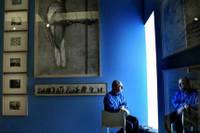William Kentridge on the positives of the cultural boycot

William Kentridge

William Kentridge believes inadequacy aids artistic development, writes Lenny Ann Low.
There are more than 10 William Kentridges pacing the Museum of Contemporary Art's galleries but only one of them is real.
The bona fide William Kentridge is sitting calmly in the corner of a blue room as curators and staff whirl past to install more than 70 animated films, drawings, etchings and sculptures for the MCA's major exhibition of Kentridge's renowned work, which opens today.
Only metres away, however, in another, much darker room, a solemn bevy of life-size Kentridges are busily tearing up charcoal drawings, plummeting to the ground from flimsy ladders, squinting into telescopes made from coffee cups and pacing ponderously ahead of a naked woman, who turns out to be the artist's wife, Anne Stanwix.
Part of a series of films made by Kentridge, the first globally acclaimed South African artist of the post-apartheid period, these magical black-and-white doppelgangers are two-dimensional self-portraits projected onto the gallery's walls. They are both a homage to the French film pioneer George Melies and a insight into the humble work methods of a very gentlemanly artist.
Like Kentridge's best-known series of animated short films, Drawings For Projection, which began in 1989 and are included in the exhibition, these flickering movies take the viewer into a world of melancholy, magic, desire and humour.
The famed animations, however, all painstakingly formed from charcoal drawings and inspired mostly by South Africa's battle to overcome the tumult of apartheid, along with the more personal struggles of two fictional characters, Soho Eckstein and Felix Teitlebaum, also bear the images of senseless death, disfigured landscapes or bureaucratic manipulations that Kentridge reveals with such mastery and lucidity.
Kentridge refers to his animation technique as "stone-age filmmaking" not least because it is almost primitive in its production.
Using paper, charcoal, limited pastels and an eraser, Kentridge draws, rubs out, draws and so forth ... hundreds of his subjects' movements in each scene on the one piece of paper while also filming it, frame-by-frame on a "very basic camera". As a result, the short animations bear the ethereal marks and smoky smears of Kentridge's industry.
"Those smudges are the remnants of me trying as hard as I can to erase something there," says Kentridge, who was born in Johannesburg, and is still based there with his wife and three children. "With charcoal on paper you don't get a perfect erasion, so what, in the end, became the central part of the way I worked was a fault that remained.
"It always takes me a while to understand that fault is the virtue. The failure of an ability to erase properly is what actually gives it its substance."
At 49, Kentridge is a keen exponent of failure's importance to an artist. He recalls a crucial turning point nearly 15 years ago when, after years "dabbling" in film, drawing and theatre, a friend told him he had to be an artist because no one was going to give him a "proper job".
"I was talking to the students at COFA [NSW College of Fine Arts] this week about being saved by one's failures," says Kentridge dressed in his customary tailored trousers and blue, long-sleeve shirt, the hue of which is a rare, though potent, element of his charcoal animations.
"I wanted to be an actor but fortunately I was so bad I couldn't practice as one. I tried working in the film industry but fortunately the film industry was so depressing and so terrible in South Africa in the years that I tried, that I went back to my studio. And, again, these pictures ended up as charcoal drawings because my oil painting was so incompetent.
"It's important to explain to students the part that chance and whim and uncertainty play in an artist's life."
Despite being virtually unknown outside of Johannesburg eight years ago, Kentridge believes the cultural boycott of South Africa during the 1980s was ultimately beneficial to the development of his work.
"There wasn't an expectation that the work would be part of the larger art conversation,' says Kentridge. "I was kind of astonished when the cultural boycott ended and people from the arts centres of the world were interested in what I had been doing."
He is also a successful creator of theatre. Since 1992, Kentridge has worked with Handspring Puppet Company, from South Africa, creating multimedia pieces using puppets, live actors and animation. A revival of the company's work The Return of Ulysses based on Claudio Monteverdi's opera and directed by Kentridge, is to be part of the Melbourne International Arts Festival in October.


<< Home